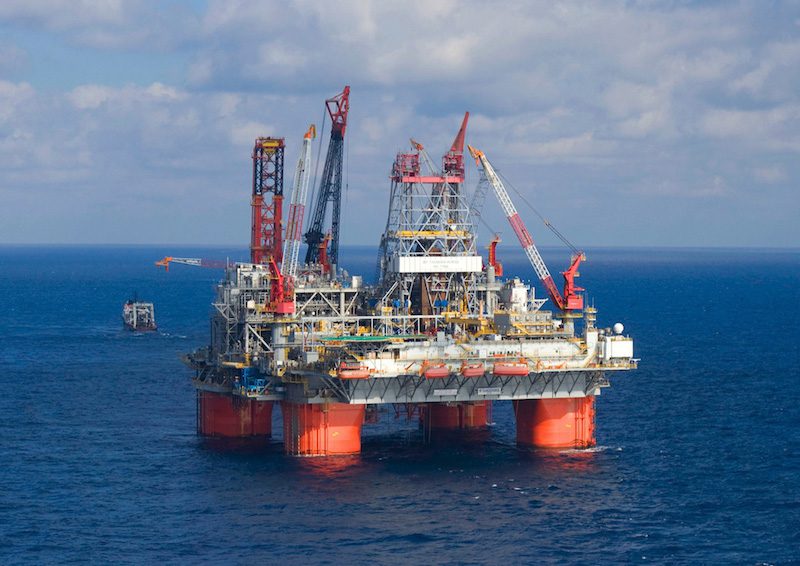BP’s Thunder Horse platform on location in the Gulf of Mexico. Photo: BP plc
 By Ron Bousso LONDON, Jan 18 (Reuters) – Buoyed by the success of seismic imaging that found an extra billion barrels of oil in the Gulf of Mexico, BP is looking to take its latest technology to Angola and Brazil.
By Ron Bousso LONDON, Jan 18 (Reuters) – Buoyed by the success of seismic imaging that found an extra billion barrels of oil in the Gulf of Mexico, BP is looking to take its latest technology to Angola and Brazil.
The software used in the Gulf, based on an algorithm created by Xukai Shen, a geophysicist straight out of Stanford University, led to BP discovering the crude in an area where it had long thought there was none to be found.
Industry experts said the scale of the discovery 8 km below BP’s Thunder Horse field, announced last week, marked a major leap forward for deepwater exploration – a costly business known for its low success rate and high risk. It is an example of how technology is helping deepwater make a comeback after a decade when the industry has focused on advances in onshore shale.
The new deposit was found with software known as Full Waveform Inversion (FWI), which is run on a super-computer and analyzes reverberations of seismic soundwaves to produce high-resolution 3D images of ancient layers of rock thousands of meters under the sea bed, helping geologists locate oil and gas.
It is more accurate than previous surveying methods, BP said, and processes data in a matter of days, compared with months or years previously.
While the discovery marked the biggest industry success for digital seismic imaging, the British oil major’s rivals are hot on its heel with similar techniques.
BP scientist John Etgen, the company’s top adviser on seismic imaging, said it aimed to retain its edge with a new machine it has developed, Wolfspar, to be used alongside FWI.
The submarine-like Wolfspar is dragged by a ship through the ocean and emits very low frequency soundwaves, which are particularly effective for penetrating thick salt layers that lie above rocks containing fossil fuels, he added.
Etgen told Reuters that BP planned to roll out Wolfspar alongside FWI in the second half of this year at the Atlantis field in the Gulf of Mexico, where a large salt layer still hides parts of the site. The company plans to expand the use of the technology to other big oil and gas basins, including Brazil next year and Angola at a later stage, he said.
“Seeing through very complex, very distorted salt bodies was the hardest problem we had, the most challenging,” the Houston-based scientist said in an interview.
In both Brazil and Angola, oil deposits are locked under thick salt layers. Brazil’s deepwater oil fields comprise one of the world’s fastest-growing basins in terms of production. BP last year signed a partnership with Brazil’s national oil company Petrobras to develop resources there.
INDUSTRY TECH RACE
Billion-barrel oil finds are rare, particularly in mature basins like the Gulf of Mexico. But the scale of output from deepwater wells means they can compete with the most low-cost basins in the world, in particular U.S. shale.
BP is far from alone in focusing on technology; all big oil companies have put a growing emphasis on digitalisation to reduce costs following the oil price collapse of 2014.
In fact, BP’s spend on R&D was the third lowest among the world’s top publicly traded oil companies in 2017 at $391 million, compared with Exxon Mobil’s $1.1 billion and Royal Dutch Shell’s and Total’s budgets of over $900 million.
Other majors have also made advances. Italy’s Eni has launched the world’s most powerful industrial computer to process seismic data, for example, while France’s Total is using drones to carry out seismic mapping in dense forests such as in Papua New Guinea.
However Barclays analysts said in a report last year that BP and Norway’s Equinor had the most advanced deployment of technology among oil majors.
‘MAGIC’ ALGORITHM
The seismic breakthrough for BP came when Xukai Shen tested a new idea he had for the FWI algorithm in 2016.
“What happened was magic – the pieces came together,” recalled Etgen. “We finally had the right algorithm with the right data set to create the model of the salt formation and use the model to remove distortion.”
BP says its new seismic technology could save it hundreds of millions of dollars in exploration hours by pinpointing the location of the most promising deposits.
“It allows us to drill the right wells, drill wells at lower costs, drill wells in the best part of the reservoir, drill fewer wells,” Etgen said.
The costs of the technology are a fraction of BP’s oil and gas production budget of around $12 billion per year.
An FWI survey costs up to $20 million to carry out, while processing the data costs up to $10 million, Etgen told Reuters. The annual spend on the super-computer that runs the software is about $20 million.
“The companies that are investing in technology are coming through and winning the race,” Henry Morris, technical director at independent North Sea-focused explorer Azinor Catalyst.
“That’s where BP are doing a good job. It’s working.”
Seeing through salt layers with confidence “adds real value” and saves companies the premiums they must pay to acquire resources through acquisitions, according to Bernstein analysts.
“With high-performance computing, the seismic processing and interpretations are being done in two weeks rather than 1,000 years, as it would have been if they still used 20th century computers,” they said.
“Investors should therefore expect more from BP with this edge.”
(Additional reporting by Shadia Nasralla; Editing by Pravin Char)
(c) Copyright Thomson Reuters 2019.

 Join The Club
Join The Club











